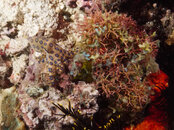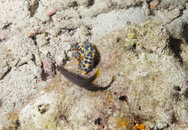You are using an out of date browser. It may not display this or other websites correctly.
You should upgrade or use an alternative browser.
You should upgrade or use an alternative browser.
Venomous Blue-Ringed Octopus
Please register or login
Welcome to ScubaBoard, the world's largest scuba diving community. Registration is not required to read the forums, but we encourage you to join. Joining has its benefits and enables you to participate in the discussions.
Benefits of registering include
- Ability to post and comment on topics and discussions.
- A Free photo gallery to share your dive photos with the world.
- You can make this box go away
CaptainCalamari
Contributor
What makes blue-rings so deadly? - The Cephalopod Page
"Often the victim doesn't even know that he had been bitten. This can make it difficult for emergency and medical personnel to determine the cause of a patient's distress. In fact, there is some question as to whether the octopus even needs to bite to envenomate a human. In cases with prolonged contact, the venom might pass directly through the skin. While most severe envenomations appear to involve bites, I can report developing mild local neurological symptoms after immersing my hand in sea water in which a large blue-ring had been shipped."
"Often the victim doesn't even know that he had been bitten. This can make it difficult for emergency and medical personnel to determine the cause of a patient's distress. In fact, there is some question as to whether the octopus even needs to bite to envenomate a human. In cases with prolonged contact, the venom might pass directly through the skin. While most severe envenomations appear to involve bites, I can report developing mild local neurological symptoms after immersing my hand in sea water in which a large blue-ring had been shipped."
Russjstewart
Contributor
It is my understanding they are often encountered in shallow water in and around bottles, cans, and shells. Just think, you find a nice shell and pick it up and then a blue-ring bites.
I think you have about one hour to get on a ventilator and then you have a chance.. Jeez
Good luck with the one hour, according to http://www.qm.qld.gov.au/~/media/Do...act+Sheets/fact-sheet-blue-ringed-octopus.pdf
"If resuscitation is not given when breathing dif culty and paralysis begin, the victim will fall unconscious and die from lack of oxygen. Death can occur within thirty minutes."
The same site says that When hunting crabs, the octopus swims over its prey and sprays poisonous saliva into the surrounding water. The victim absorbs the venom and is paralysed in minutes. Alternatively, prey may be captured with the tentacles (which bear long rows of suckers) and paralysed by a venomous bite. Prey is usually torn apart before being eaten. The link is well worth reading.
Back in the day when I was a lifesaver in Melbourne Victoria we would get a couple of beach goers a year come up to the life saving club house asking what the creature in the bucket. Some had been picked up with bare hands. No one had ever been bitten, possibly more good luck than anything
ScubaEm65
Registered
The pictures you attached are amazing! Thank you for sharing
Last edited:
Dan
Contributor
View attachment 407058 My husband found us this little guy on our anniversary in Malapascua.
Nice! I have never seen the red variation before.
iamrushman
Contributor
thanks all of you for the info and the great photos...keep it coming.
gert7to3
Contributor
- Messages
- 1,167
- Reaction score
- 119
- # of dives
- 200 - 499
I have no idea how tippytoes12's photo got onto my following post.
Last edited:
gert7to3
Contributor
- Messages
- 1,167
- Reaction score
- 119
- # of dives
- 200 - 499
iamrushman
Contributor
nice series of photos....i see the different phases...
Similar threads
- Replies
- 1
- Views
- 689
- Replies
- 7
- Views
- 909
- Replies
- 2
- Views
- 643






